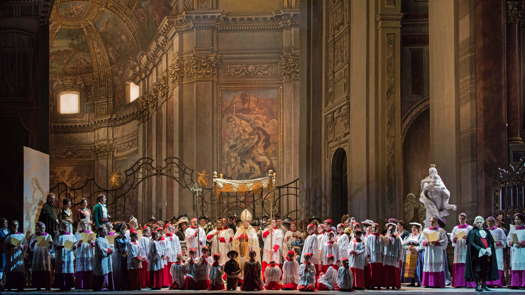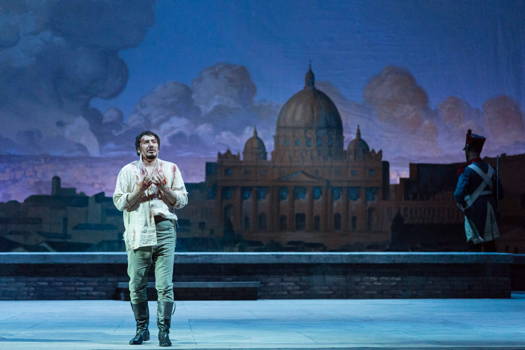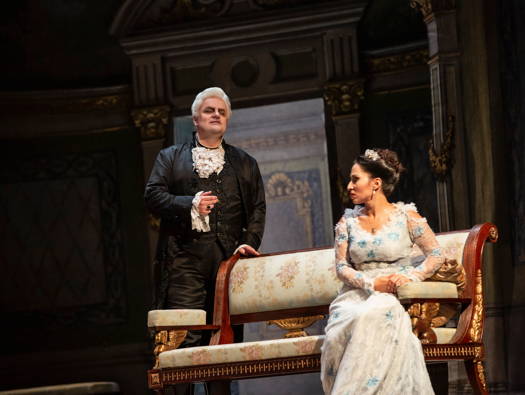 FEEDBACK: She said WHAT? Read what people think about our Classical Music Daily features, and have your say!
FEEDBACK: She said WHAT? Read what people think about our Classical Music Daily features, and have your say!
- Giovanni Maria Bononcini
- San Diego Opera
- World War One
- Rudolf George Escher
- Note 1 Musikvertrieb GmbH
- Bellini: Norma
- piano trios
- Johann Christoph Denner
 DISCUSSION: John Dante Prevedini leads a discussion about Composers, individuals or collective?, including contributions from David Arditti, Halida Dinova, Robert McCarney and Jane Stanley.
DISCUSSION: John Dante Prevedini leads a discussion about Composers, individuals or collective?, including contributions from David Arditti, Halida Dinova, Robert McCarney and Jane Stanley.
A Repertory Tosca
GIUSEPPE PENNISI considers Puccini's opera
as a real orchestral masterpiece
14 January 1900 is considered a turning point in Italian music - the real start of the music of the twentieth century as well as of the Italian style of music drama. It is the date of the debut of Tosca in the then-named Teatro Costanzi in Rome, now the Teatro dell'Opera di Roma. It was a tremendous triumph and left long-lasting implications on musical theatre, especially in Italy, but also elsewhere.
Tosca needs no introduction. The opera is one of Giacomo Puccini's war horses as well as one of the most performed music dramas worldwide. The plot develops on a single day and on a precise date - 14 June 1800 - around the misleading information reaching Rome on the outcome of the Marengo battle during a Napoleonic campaign to conquer Italy. At that time, communication was not so good; in the afternoon, the news reached Rome that Napoleon had been defeated and celebrations were arranged somewhat in a hurry to thank God and the anti-French coalition. This was what is now called 'fake news'. Late at night, the correct information arrived: the coalition had been beaten and Napoleon was marching up toward Rome.
During these few hours, the sadistic and sex-obsessed Chief of the Rome police, Scarpia, attempts to rape the singer Floria Tosca, who is in love with the liberal painter Mario Cavaradossi. Tosca stabs and kills Scarpia, but Cavaradossi is executed by a firing squad and the protagonist throws herself into the Tiber. The late music reviewer Paul Hume used to call Tosca 'a blood and guts drama'. It is full of musical innovations that made a mark and still fascinate the audience: a symphonic tapestry with key themes in the pit, melodious declamation opening into arias and arioso, an excellent balance between orchestra and stage, and tense and fast-paced action.
However, in recent stagings, the events are often moved by stage directors to other times, especially to that of Fascism, for example in the Jonathan Miller, Peter Sellars, Robert Carsen and Pierluigi Pizzi productions often reviewed here. In 2015, Teatro dell'Opera di Roma unveiled a production that is a philological Tosca, exactly as it was performed on 14 January 1900. (Read A Philological Tosca, 8 March 2015, Music & Vision Magazine.) It was so successful that it became a repertory item, performed some fifteen-twenty times on a non-subscription basis each year. I attended the 21 June 2019 performance.

A scene from Puccini's Tosca at Teatro dell'Opera di Roma. Photo © 2015 Yasuko Kageyama
On the basis of the sketches and a few photos from 1900, the theater's laboratories faithfully reconstructed the sets and costumes by Adolf Hohenstein, based on French paintings of the late nineteenth century: as the pictures show, they are a joy to the eyes. It is understandable that the then Queen of Italy was enthralled by the costume worn by Tosca in Act I, and demanded that similar attire be tailored for her.
In Italy in 1900, there was no stage direction as we understand it now. South African-Italian stage director Alessandro Talevi scrupulously follows the scenic indications written by Puccini and librettists Giuseppe Giacosa and Luigi Illica for the debut. They are no more than notes. Talevi added effective acting which, during the last few years, has become more sophisticated. In 2015, I wrote that the tenor Stefano La Colla was, himself, a coup de théâtre. Then, he was scheduled to sing only two of the fifteen performances - almost a consolation prize for a 'cover'. However, he had to step in because the 'star' was ill. On 21 June, he interpreted Mario Cavaradossi quite well. In the first act, the audience applauded him warmly as he sang 'Recondite Armonie', the hard opening aria based entirely on the centre register. As the opera went on, when La Colla sang 'E Lucevan Le Stelle' in the third act, the theatre exploded with accolades, ovations and requests for an encore.

Stefano La Colla as Cavaradossi in Puccini's Puccini's Tosca at Teatro dell'Opera di Roma. Photo © 2015 Yasuko Kageyama
The Romanian Sebastian Catana is a well-versed veteran Scarpia. In the title role was Russian dramatic soprano Svetlana Kasyan, another experienced Tosca. She has a well-set voice and a good volume, but on 21 June her diction sounded flawed. Nonetheless, she received a long applause after 'Vissi d'Arte' in Act II.

Svetlana Kasyan in the title role of Puccini's Tosca at Teatro dell'Opera di Roma, with Sebastian Catana as Scarpia. Photo © 2015 Yasuko Kageyama
The chorus and childrens' choir (led by Roberto Gabbiani) were as usual very professional.
Often, when reviewing performances of Tosca, attention is mostly, if not solely, given to the voices. But in fact, Tosca is a real orchestral masterpiece. The Teatro dell'Opera orchestra plays the score several times each year and knows it inside-out. On 21 June, the conductor was Jordi Bernàcer, a young Spanish musician who is the new resident conductor of San Francisco Opera. In Italy, he often works at Teatro San Carlo in Naples and in the Verona Arena. This was the first time that I listened to and watched his conducting, and it was a great discovery. He has developed an excellent empathy with the orchestra. Together they underlined the complexity, beauty and modernity of this sophisticated score. In addition, Bernàcer gave cues to the singers very carefully and, thus, led the whole performance.
A great success.
Copyright © 25 June 2019
Giuseppe Pennisi,
Rome, Italy



